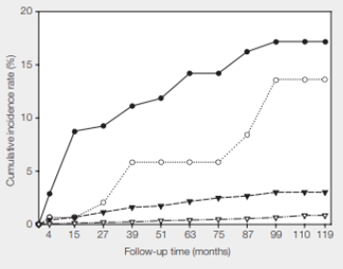
Concept explainers
Cervical Cancer Incidence in HPV-Positive Women
A persistent infection with one of about 10 strains of genital HPV (human papillomavirus) is the main risk factor for cervical cancer. The virus spreads easily by sexual contact, but vaccines that prevent infection have been available since 2006. The vaccines consist of viral proteins that self-assemble into virus-like particles. The particles are not infectious (they contain no viral DNA), but their component proteins trigger an immune response that can prevent HPV infection and the cervical cancer it causes.
In 2003, Michelle Khan and her coworkers published results of their 10-year study correlating HPV status with cervical cancer incidence in women (FIGURE 37.23). All 20,514 participants were free of cervical cancer when the study began.

FIGURE 37.23 Cumulative incidence rate of cervical cancer correlated with HPV status.
● HPV16 positive
○ HPV16 negative and HPV18 positive
▾ All other cancer-causing HPV types combined
▿ No cancer-causing HPV types was detected.
At 110 months into the study, what percentage of women who were not infected with any type of cancer-causing HPV had cervical cancer? What percentage of women who were infected with HPV16 also had cancer?
To determine: The percentage of women who were not infected with any type of cancer-causing HPV, but had cervical cancer.
Introduction: The researchers in the given study attempted to make a connection between the presence of various HPV viral infections and the incidence of cervical cancer. Cervical cancer arises from the cervix, which occurs due to the abnormal growth of the cells that have the capability to invade or spread to other body parts.
Explanation of Solution
The given study showed that approximately one percent of the women who had no cancer-causing HPV infections developed cervical cancer. The study shows that the infection with the genital HPV is the main risk factor for cervical cancer. The women who have not been infected with cancer-causing HPV have a small chance of having cervical cancer. HPV is not the only cause of cervical cancer. It can also be caused due to a weakened immune system, long-term mental stress, giving birth at a very young age, several pregnancies, birth control pills, and so on.
In the given study, 1% of women who were not infected with any type of cancer-causing HPV had cervical cancer.
To determine: The percentage of the women who were infected with HPV16 had cancer.
Introduction: The researchers in this study attempted to make a connection between the presence of various HPV viral infections and the incidence of cervical cancer. Cervical cancer arises from the cervix, which occurs due to the abnormal growth of the cells that have the capability to invade or spread to other body parts.
Explanation of Solution
At 110 months, 17 percent of the women who tested positive for HPV16 had cervical cancer. Human papillomavirus that spreads easily by sexual contact is a risk factor for cervical cancer. The study indicates that those women who are HPV-positive have a high risk of getting cervical cancer.
The HPV positive women, who have the habit of smoking and have HIV influence, are more likely to develop cervical cancer. If the virus infection is left untreated, the pre-cancerous cells will develop to cancer cells, but it will take 10 to 15 years.
In the given study, 17 percent of the women who were infected with HPV16 had cancer.
Want to see more full solutions like this?
Chapter 37 Solutions
Biology: The Unity and Diversity of Life (MindTap Course List)
Additional Science Textbook Solutions
Concepts of Genetics (12th Edition)
Campbell Biology (11th Edition)
Laboratory Experiments in Microbiology (12th Edition) (What's New in Microbiology)
Genetics: Analysis and Principles
- Many viruses enter host cells through receptor- mediated endocytosis, What is an advantage of this entry strategy? The virus directly enters the cytoplasm of the cell The virus is protected from recognition by white blood cells The virus only enters its target host cell type The virus can directly inject its genome into the cell’s nucleus.arrow_forwardBox one: • Human breast cancer cell line BT474, which overexpresses HER2, in 10 cm Petri dishes• Human HER3 ligand• Lapatinib• Lysis buffer A (containing 1% Triton and 0.1% SDS)• Lysis buffer B (containing no detergent)• Mouse anti-HER3 antibodies• Mouse anti-pY1289 of HER3, that recognises the phospho-tyrosine at position1289 of Her3• Mouse anti-actin antibodies• Horseradish peroxidase (HRP)-conjugated anti mouse IgG antibodies• SDS-PAGE Sample buffer (contains SDS, mercaptoethanol and bromophenolblue)• Molecular weight markers• SDS-PAGE gel• Nitrocellulose membrane• Phosphate buffered saline (PBS)• Blocking buffer (5%w/v BSA in PBS)• X-ray film• Luminol/H2O2 (hydrogen peroxidearrow_forwardWound healing and mitotic rates in the damaged cornea of a mouse. The level of DNA replication in corneal epithelial cells in mice is high in the morning and low in the afternoon/evening. As a consequence, injury in the morning is expected to lead to accelerated entry into mitosis and wound repair compared to injury in the afternoon/evening. Shaded areas indicate dark periods and ZT stands for Zeitgeber Time (24 hour period).arrow_forward
- CHOICES: Isoniazid Rifampicin Ethambutol None of the Choices Causes more adverse effects to slow acetylators Causes optic neuritis Causes orange secretions Inhibits transcription process in mycobacteria Binds to bacterial DNA gyrase & topoisomerasearrow_forwardquestion: Can you summarize and explain for me what you want to tell in the article below? When I read it myself, I do not understand exactly what is meant by the article. It would be nice if you could highlight the important points. You can use them in a figure or diagram to explain. thank you and hava a nice day :) Article: Interference with Cellular Uptake, Immobilization, and Inactivation of the Virus Outside of the Host Cell Nanomaterials can be synthesized with a high specific surface area of a few hundred square meters per gram. Therefore, dependent on the surface properties, nanomaterials efficiently adsorb biomolecules and form a so-called biomolecular corona. This passive, nontargeted adsorption might be utilized to bind viruses, provided that the selected nanomaterial is relatively biocompatible. Viral surface proteins are often modified by sugar moieties or encompass positively charged amino acid patches that bind to lectins or glycosaminoglycans (GAGs) of heparan sulfate…arrow_forwardTrue or False? p21 inhibits the S-cyclin/S-Cdk complex.arrow_forward
- 19. Tumor suppressor genes/Oncogenes: Describe how viruses can lead to cancer formation in animal hosts. In your response, describe the terms tumor suppressor gene, proto-oncogene, and oncogene. Use HPV as an example of how different types of tumors may develop and why it may be advantageous to a virus to interfere with proto- oncogenes or tumor suppressor genes.arrow_forward(35) Human immunization with purified polysaccharide antigens generates a response that is not dependent on T-lymphocytes control. As a result switching of immunoglobulin class during immune response does not occur . Therefore,the human immune response 2 months after vaccination with purified polysaccharide involves primarily which of the following immunoglobulin classes? (A) IgA. (B) IgD. (C) IgE. (D) IgG.…arrow_forwardMultiple choice 1.) An Action potential A. is essential for nerve impulse propagation B. involves the influx of negative ions to depolarize the membrane C. involves the outflux of negative lons to depolarize the membrane D. Involves the outflux of positive ions to depolarize the membrane 2.) Which function can be carried out by DNA replication proteins? A. Topoisomerases wind the DNA into a double-helix. B. DNA ligase can initiate new DNA chains C. SSB converts double-stranded DNA into single-stranded DNA. D. Helicases break hydrogen bonds in the DNA. 3.) Which mechanism contributes to accuracy during DNA replication? A. The mismatch repair system recognizes an incorrect base-pair and corrects the mistake in the non-methylated strand. B. Using primers increases accuracy because the first nucleotides in a new nucleic acid chain are more likely to be correct. C. All DNA polymerases have a 5'-3' exonuclease activity which can remove incorrect nucleotides during…arrow_forward
- Southern Blotting & Detection of sickle cell disease: - Please label the figure and discuss each lane, and draw a Punnett square. - Finally, discuss the results at length.arrow_forwardCASE STUDY Cancer-killing bacteria Ralph, a 57-year-old man, was diagnosed with colon cancer.His oncologist discussed the use of radiation andchemotherapy as treatments, both of which can causedebilitating side effects. Ralph decided to explore other optionsand went to a cancer clinic. He learned that researchers in asynthetic biology program were testing the use of geneticallymodified bacterial cells designed to selectively invade specifictumors and kill cancer cells, with no effects on normal cells.Ralph decided to participate and was informed that he wouldbe part of a phase III trial, comparing the effects of the modifiedbacterial cell treatment against conventional chemotherapy.However, as part of the trial, he would be randomly assigned toreceive one or the other treatment. He was disappointed to learnthis, because he assumed that he would receive the bacterialtherapy.Question: Informed consent is legally and ethically required beforesomeone participates in a clinical trial.…arrow_forwardQuestion:- Which of the following is true of proto-oncogenes? They tend to be genes functioning in highly differentiated cells They tend to be pleiotropic genes They originate in retroviruses They are formed following viral infection None of the above.arrow_forward
 Biology 2eBiologyISBN:9781947172517Author:Matthew Douglas, Jung Choi, Mary Ann ClarkPublisher:OpenStax
Biology 2eBiologyISBN:9781947172517Author:Matthew Douglas, Jung Choi, Mary Ann ClarkPublisher:OpenStax
